Rullekake, otherwise known as a roulade or Swiss roll cake, is a simple yet versatile and delicious cake based on sukkebrød which we call a sugary sponge cake and is the base for Norwegian bløtkaker and marzipan cakes as well.
Rullekake is typically layered with jam and whipped cream. Other popular fillings include buttercream of various types and even mashed bananas.
In the U.S. a version of this cake also goes by ‘jelly roll’ so it’s not a Norwegian invention and neither is it a Swiss one despite one of its names. Either way, it’s delicious!
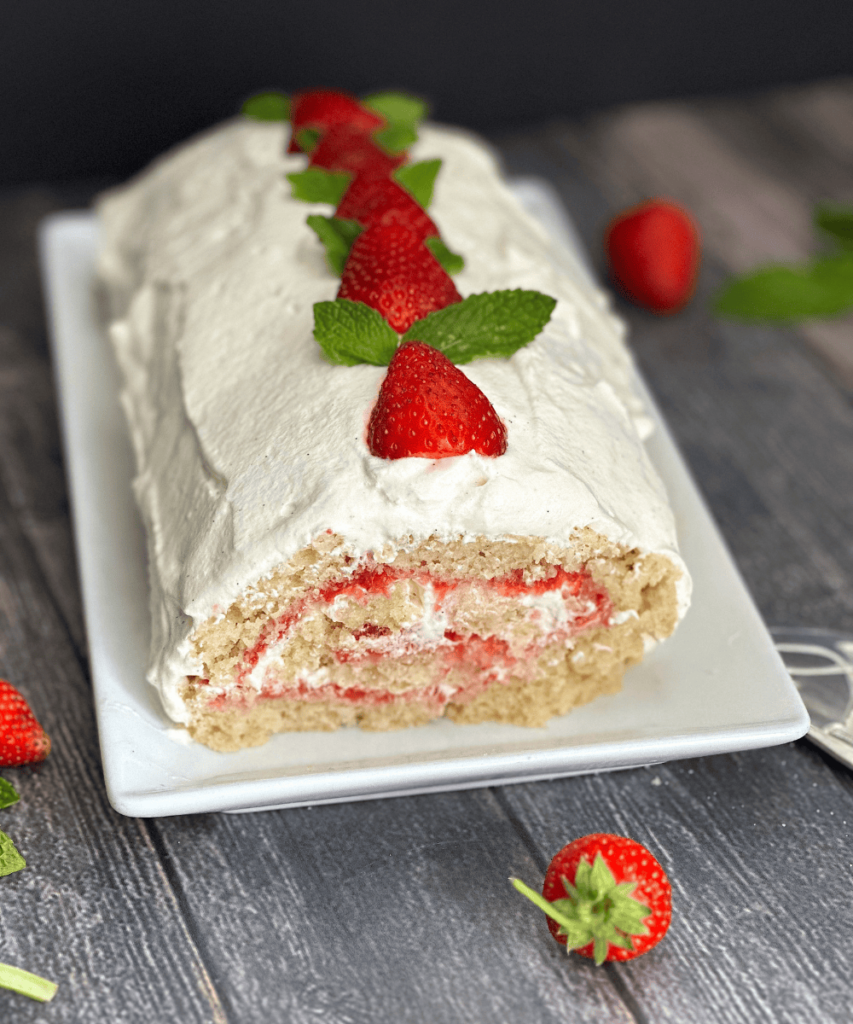
Many Norwegians might have memories of rullekake from childhood. Known for being a grandmother’s favorite, it’s quick and easy to make and ensured that any potential guests that would pop over for afternoon or evening coffee would get something sweet to enjoy.
The oldest recipe for sukkebrød known in Norwegian-Danish tradition is from Helle Schrøder’s handwritten cookbook, which she started writing in 1692 in Ringsted, Denmark. At that time the cake had to be baked in a tart pan over open fire.
If you know anything about baking a sponge cake, there’s a big risk of the cake sinking in the middle if you even bake it in a traditional oven, so it could not have been easy making this back then.
The name is of German origin and was used initially to describe regular bread that was sprinkled with sugar.
But back to today’s recipe: I finally managed to make a vegan version that has both the texture and flavor I was looking for and remember from growing up tasting these cakes.
The most common difficulty people have with this cake, whether vegan or not, is to avoid the cake from breaking or ‘cracking’ as you roll it up.
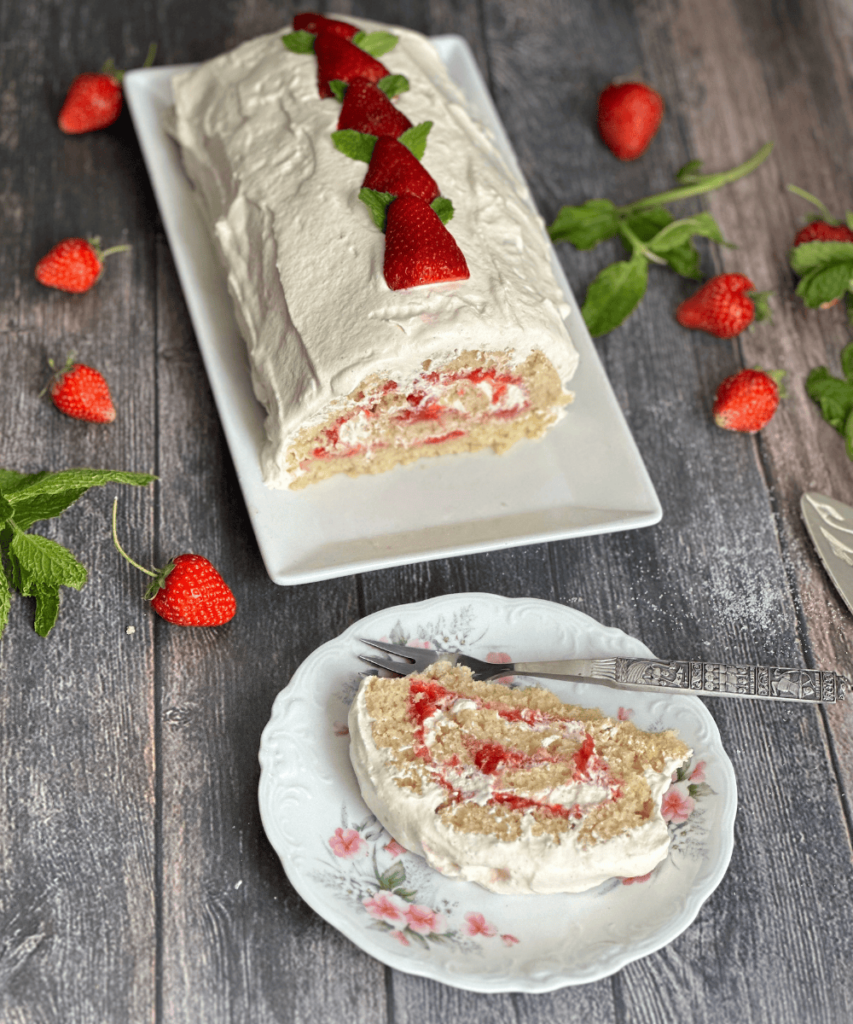
Here are my top 5 tips to successfully bake this cake:
- The key to making the cake pliable and avoid it cracking as you roll it up: add a little cornstarch AND some xanthan gum to the dough! The amounts are small so won’t affect the flavor or texture much (in my opinion—and my chef husband’s, who gobbled up the cake!)
- Don’t wait to roll up the cake until it’s completely cooled, it should still be warm as it will hold onto some of that softness that you need in order for it not to break when you shape it into a roulade.
- Sprinkle sugar on either parchment paper or a clean kitchen towel and use that to first roll it up as it’s still somewhat warm, while you make the filling. Let the cake completely cool before you spread on the filling. I tried both rolling it up on parchment and a kitchen towel, and I preferred the kitchen towel as it seemed to hold the shape better.
- Sparkling water makes the cake lighter and gives it a nice touch, as does a little apple cider vinegar!
- Adding a little cream of tartar to the whipped cream helps stabilize and firm it up even more so it doesn’t turn runny. It’s not necessary but I found it to be a nifty addition.
I hope you will feel inspired to bake this cake—it really is simple once you follow these steps and the recipe and it won’t take long!
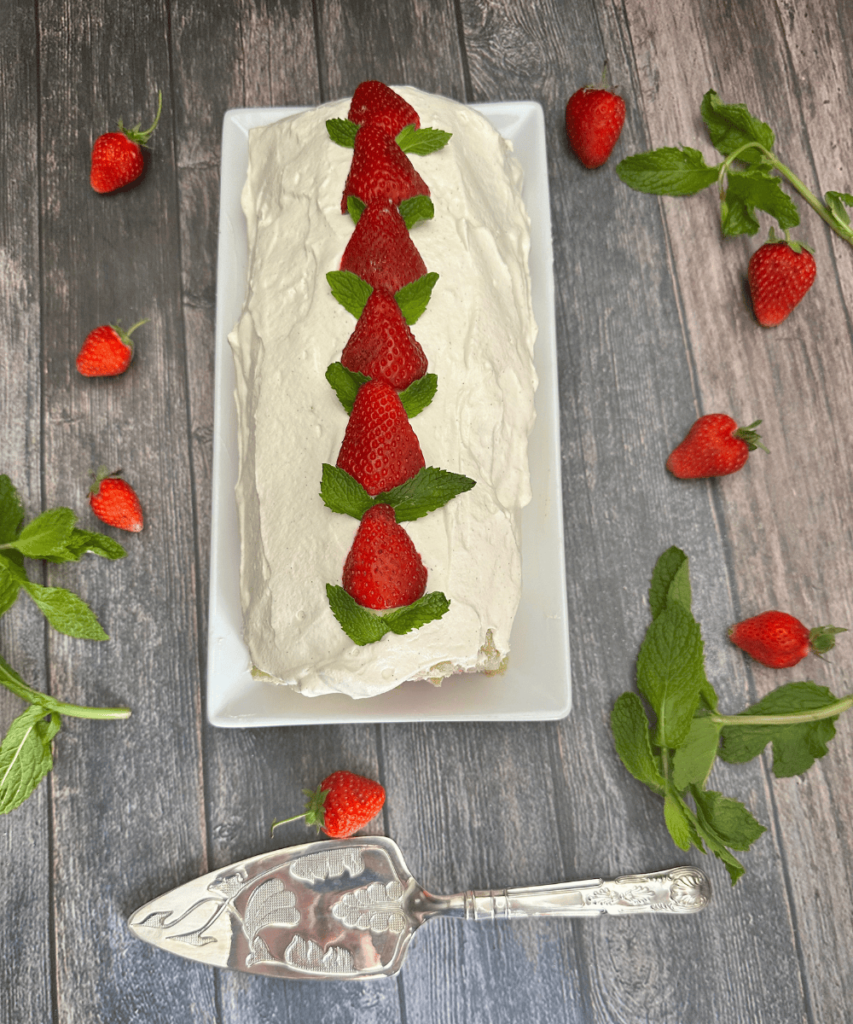
NORVEGAN RULLEKAKE
Sponge Cake:
2 cups (240 grams) all-purpose flour
2 ½ tablespoons cornstarch
2 teaspoon baking powder
½ teaspoon xanthan gum
1 heaping teaspoon vanilla sugar*
1 teaspoon baking soda
½ teaspoon salt
¾ cups (150 grams) sugar
1 ¼ cup (300 ml sparkling water)
¼ cup (60 ml) neutral vegetable oil
2 teaspoons apple cider vinegar
Additional sliced strawberries for garnish
Fresh mint for garnish (optional)
*you can sub vanilla extract but then add it to the wet ingredients
Strawberry Jam:
300 grams (scant 2 cups) strawberries, cored and quartered
½ cup (100 grams) granulated or powdered sugar
Zest and juice of 1 small lemon
2 tablespoons cornstarch
Whipped Cream:
500 ml (17 oz) vegan whipping cream like Country Crock, Silk or Violfie
¼ teaspoon cream of tartar (optional but helps stabillize cream)
⅓ cup (35 grams) powdered sugar
1-2 teaspoon vanilla paste or extract
To make sponge cake:
Preheat the oven to 350℉ (175℃).
Line a 17.9 x 12.9-inch baking sheet with parchment paper. I like to spray or grease the sheet a little with oil before I place the parchment paper down so it doesn’t slide once I spread the batter onto the pan.
Sift the flour, cornstarch, baking powder, xanthan gum, and vanilla sugar into a medium bowl and whisk well. Add the baking soda, salt, and sugar and whisk again to combine.
In a measuring cup or small bowl, combine the sparkling water, oil, and apple cider vinegar (and if using, vanilla paste or extract) and pour into the dry ingredients. Fold carefully together until just combined using a spatula, being careful not to overmix.
Pour the batter onto the prepared baking sheet in an even layer (use an offset spatula if you have one).
Bake in the oven for about 18-20 minutes until the edges are set and the center comes out clean when inserting a cake tester.
Cool on a wire rack in the pan for about 10 minutes, before carefully sliding the cake off the pan onto the wire rack to prevent the bottom from steaming.
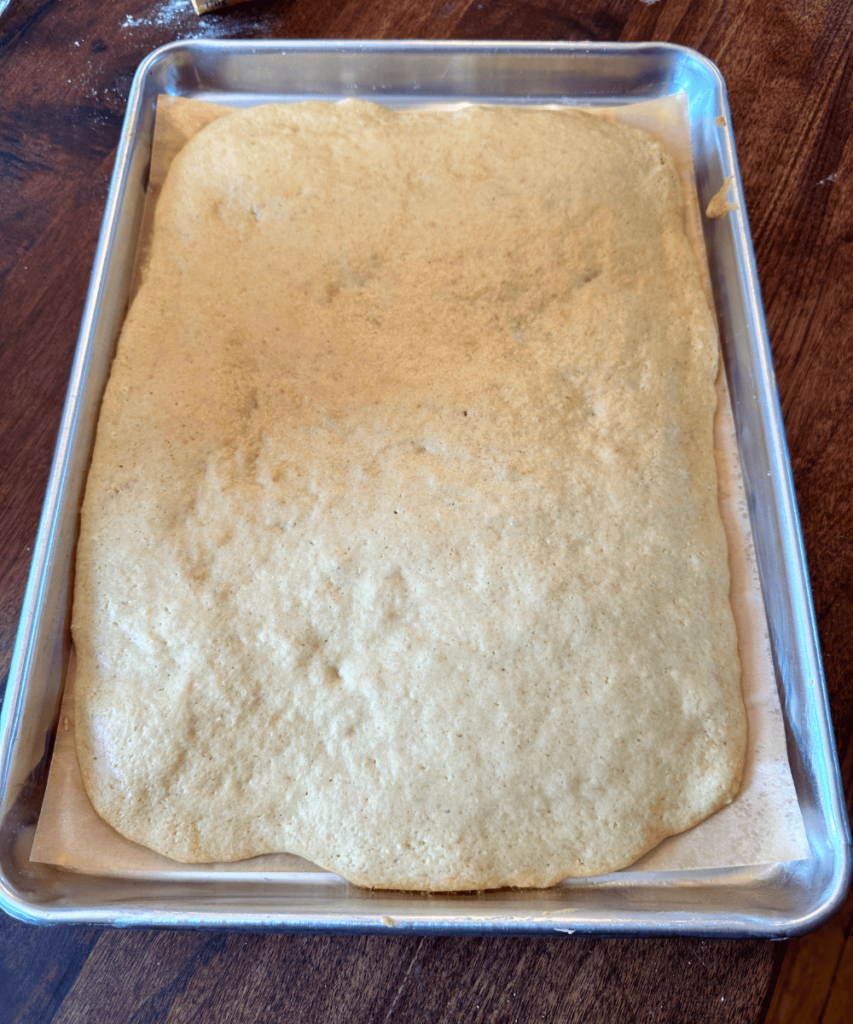
While the cake is resting, sprinkle some sugar onto a clean, thin dish towel or a sheet of parchment paper.
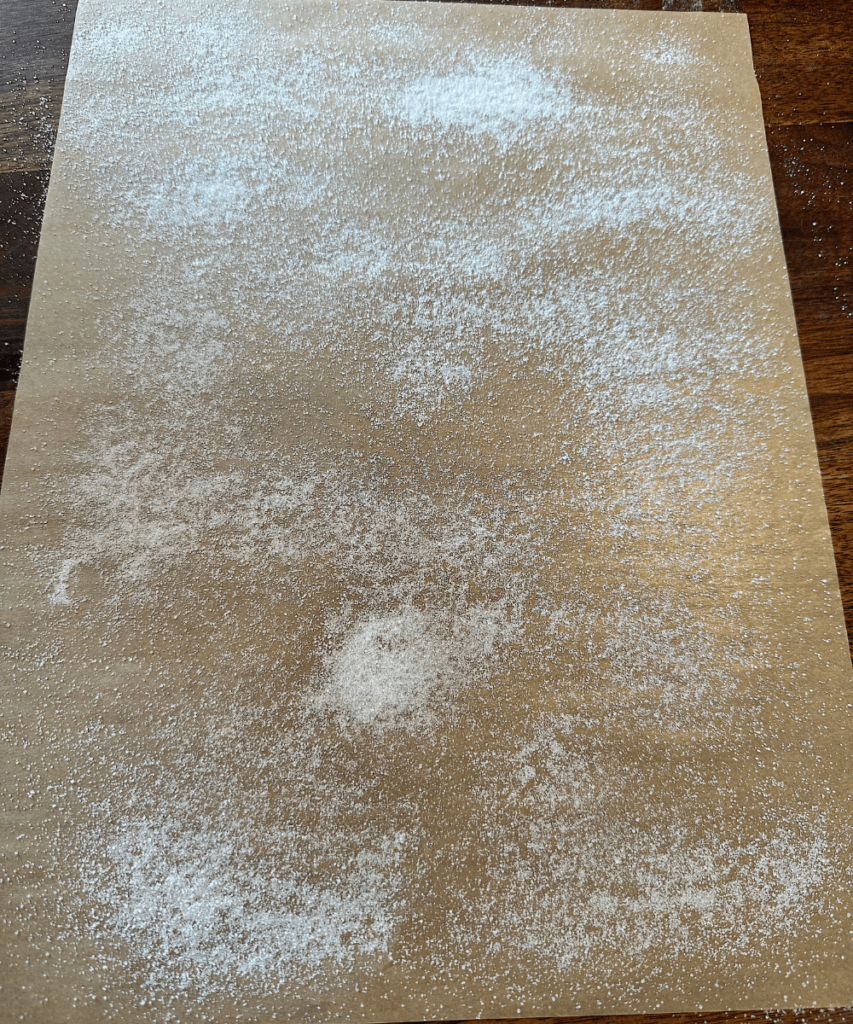
Do NOT let the cake cool completely before rolling. Invert the cake onto the sugared dish towel and gently remove the parchment paper. Carefully roll the cake using the dish towel into a roulade, not too tightly but not too loosely. Let sit, seam-side down until completely cooled.
While the cake is cooling make the strawberry jam:
Add the strawberries, sugar, lemon zest, and juice into a heavy-bottomed small pan over medium heat, stirring until the sugar starts to dissolve and the juices from the strawberries start to seep out.
Add the cornstarch and cook for several more minutes until the mixture thickens.
Pour onto a half-sheet pan and let cool completely.
Make the whipped cream:
Add all the ingredients into a bowl of a stand mixer or a big bowl if using a hand mixer, and whisk for 2-3 minutes until firm peaks are formed.
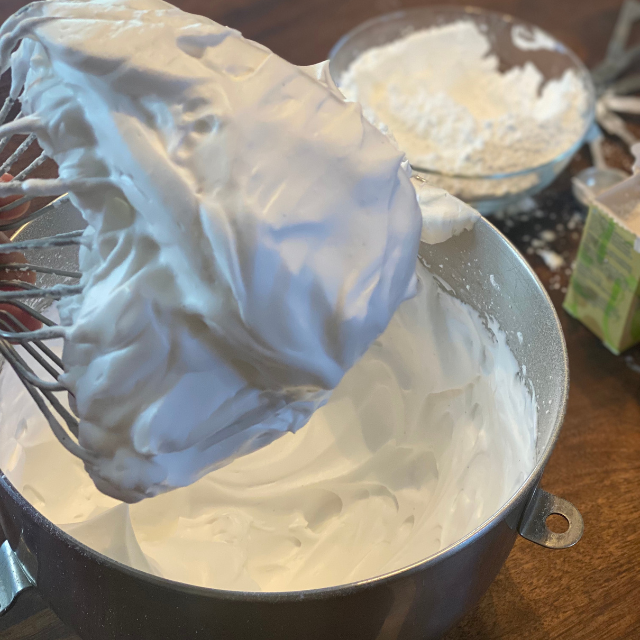
Assemble the cake:
Carefully roll the cake back out, and brush off any excess sugar.
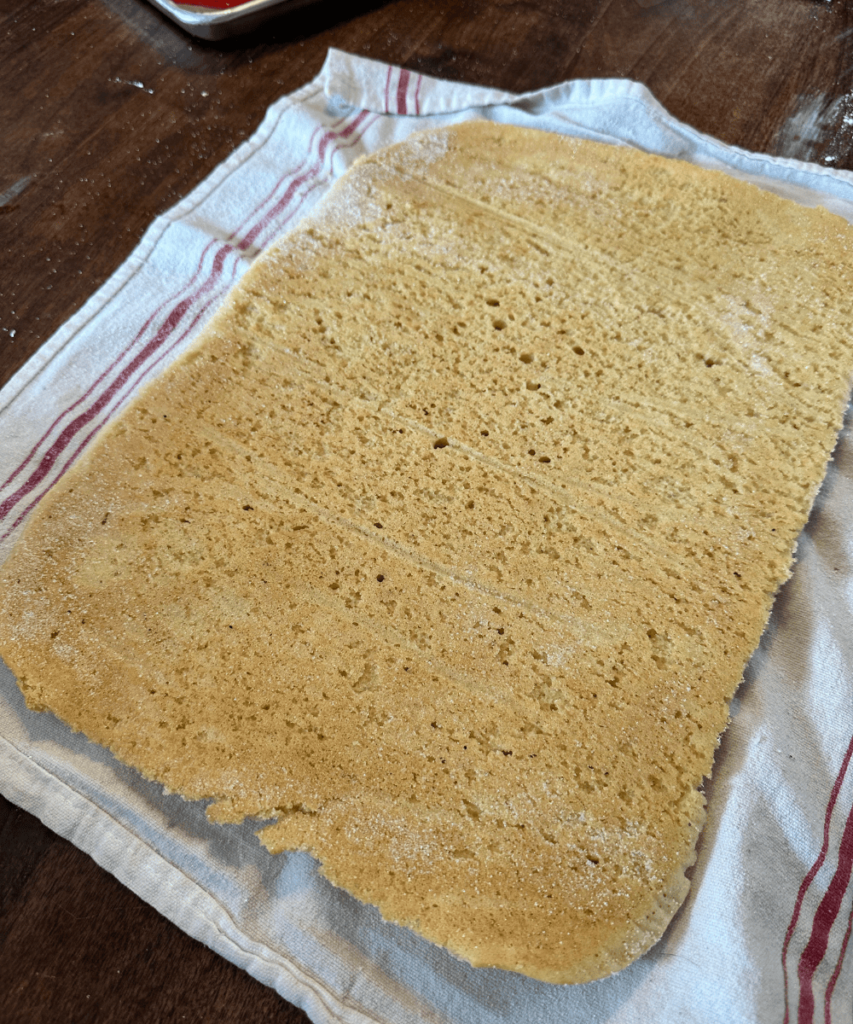
Spread a thin layer of the strawberry jam over the cake, followed by a thin layer of whipped cream, leaving about 1-inch (2 ½ cm) space from the edges.
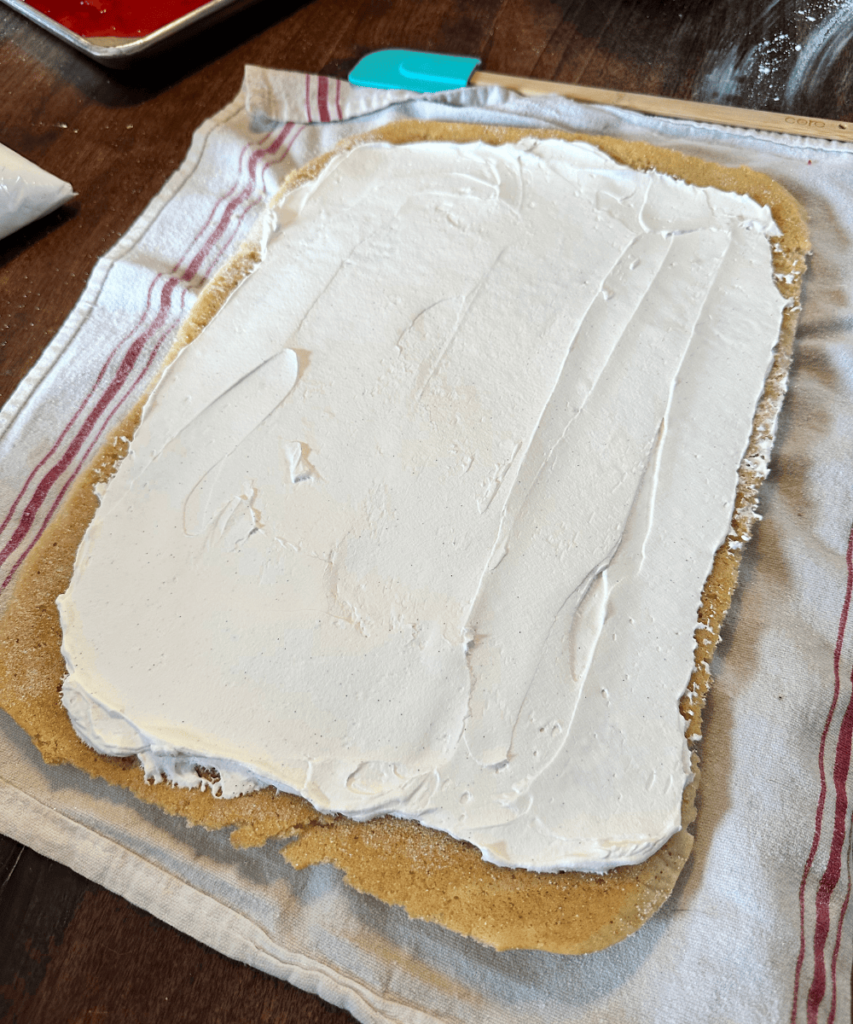
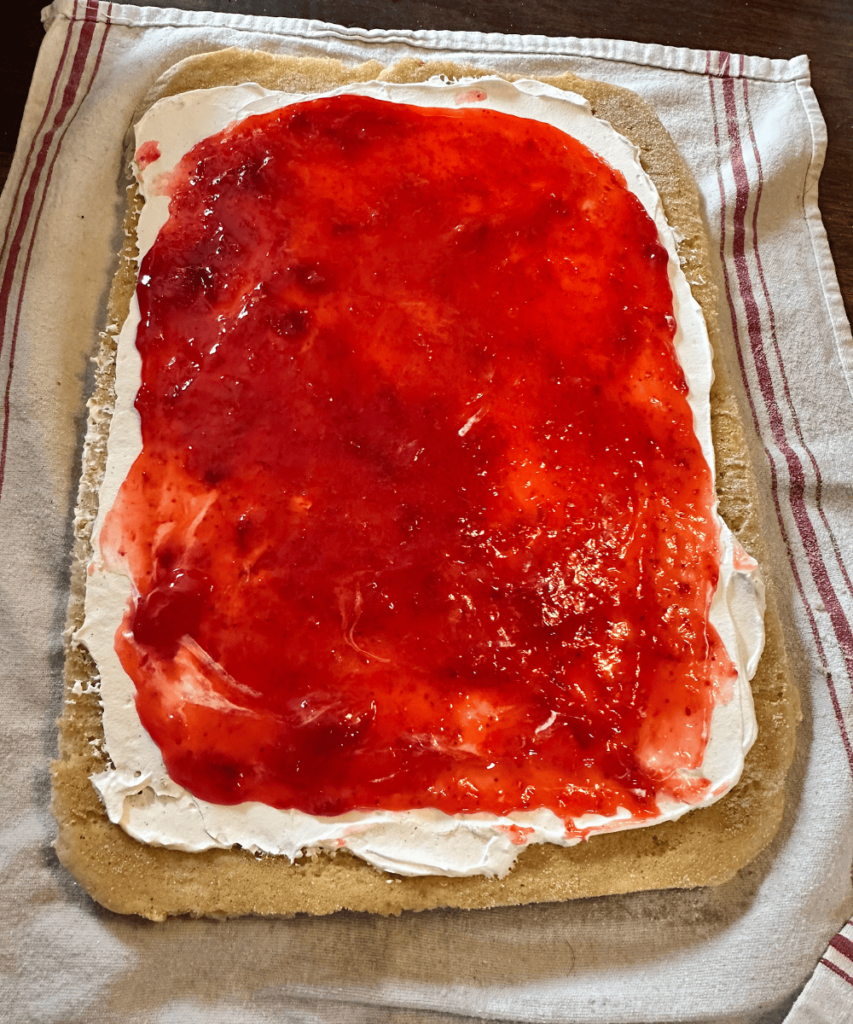
Carefully roll the cake back together and place it on a serving tray with the seam side down.
Spread the remaining whipped cream over the cake and decorate with slides strawberries and small leaves of fresh mint if desired. Keep in fridge.
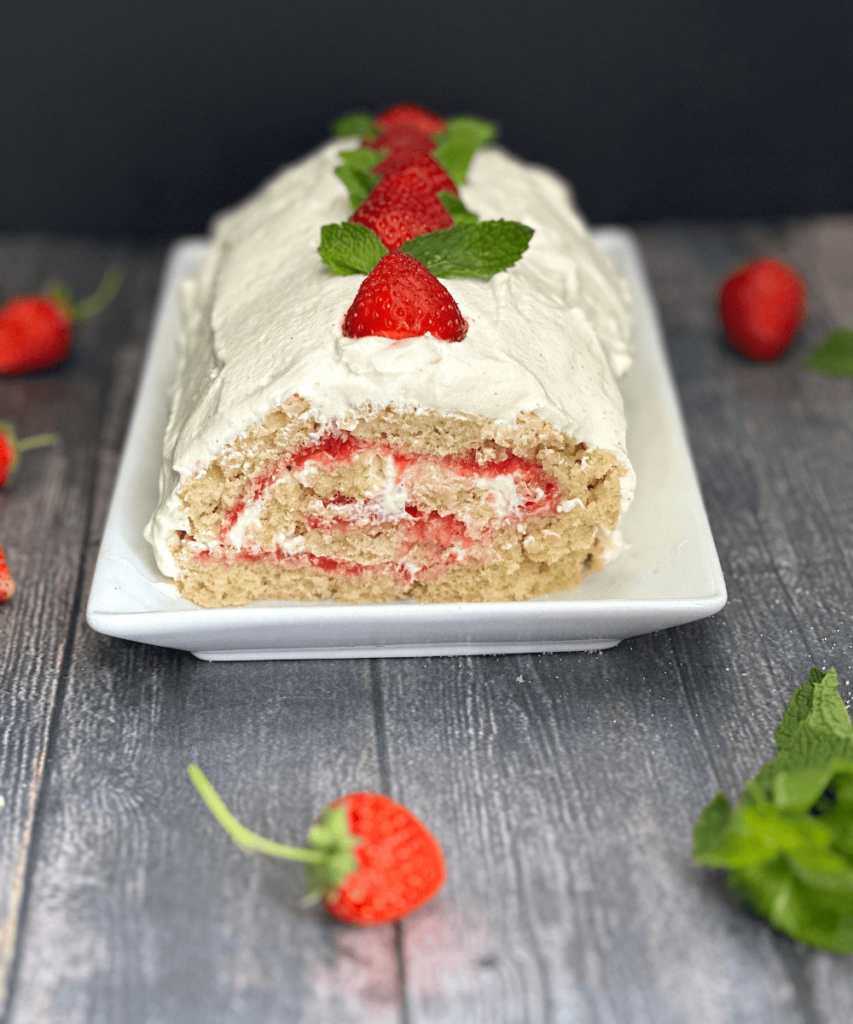
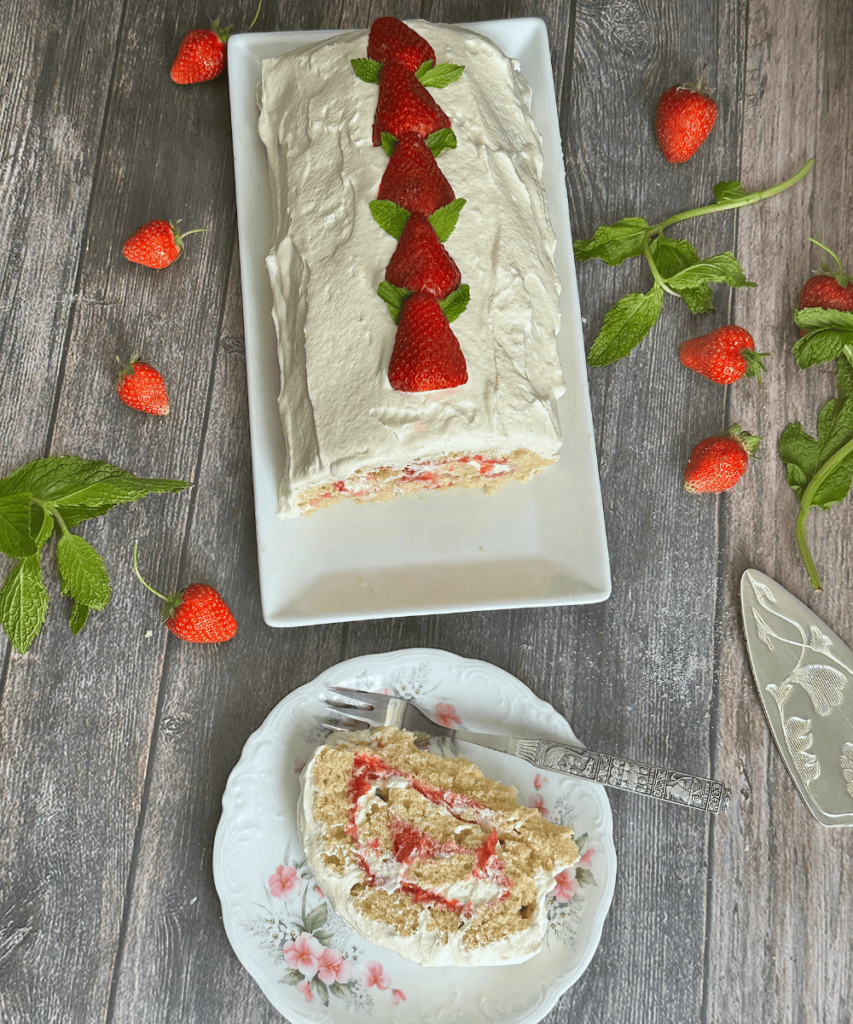

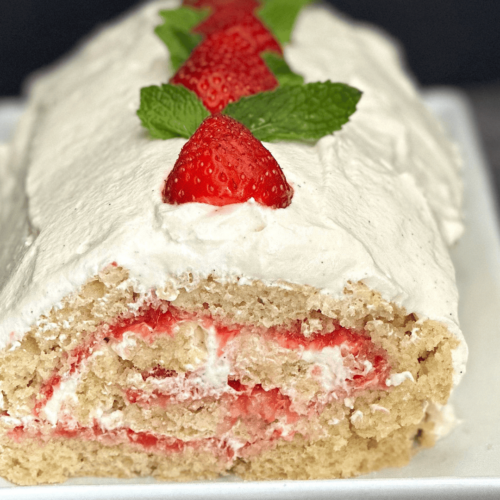
Norvegan Strawberry Rullekake
Ingredients
Sponge Cake:
- 2 cups 240 grams all-purpose flour
- 2 ½ tablespoons cornstarch
- 2 teaspoon baking powder
- ½ teaspoon xanthan gum
- 1 tsp vanilla sugar*
- 1 teaspoon baking soda
- ½ teaspoon salt
- ¾ cups (150 grams) sugar
- 1 ¼ cup (300 ml) sparkling water
- ¼ cup (60 ml) neutral vegetable oil
- 2 teaspoons apple cider vinegar
- Additional sliced strawberries for garnish
- Fresh mint for garnish optional
Strawberry Jam:
- 300 grams (scant 2 cups) strawberries, cored and quartered
- ½ cup (100 grams) granulated or powdered sugar
- Zest and juice of 1 small lemon
- 2 tablespoons cornstarch
Whipped Cream:
- 500 ml (17 oz) vegan whipping cream like Country Crock, Silk or Violfie
- ¼ teaspoon cream of tartar optional but helps stabillize cream
- ⅓ cup (35 grams) powdered sugar
- 1-2 teaspoon vanilla paste or extract
Instructions
To make sponge cake:
- Preheat the oven to 350℉ (175℃). Line a 17.9 x 12.9 inch baking sheet with parchment paper. I like to spray or grease the sheet a little with oil before I place the parchment paper down so it doesn’t slide once I spread the batter onto the pan.
- Sift the flour, cornstarch, baking powder, xanthan gum, and vanilla sugar into a medium bowl and whisk well.
- Add the baking soda, salt, and sugar and whisk again to combine.
- In a measuring cup or small bowl, combine the sparkling water, oil and apple cider vinegar (and if using, vanilla paste or extract) and pour into the dry ingredients. Fold carefully together until just combined using a spatula, being careful not to ovemix.
- Pour the batter onto the prepared baking sheet in an even layer (use an offset spatula if you have one).
- Bake in the oven for about 18-20 minutes until the edges are set and the center comes out clean when inserting a cake tester.
- Cool on a wire rack in the pan for about 10 minutes, before carefully sliding the cake off the pan onto the wire rack to prevent the bottom from steaming.
- While the cake is resting, sprinkle some sugar onto a clean, thin dish towel.
- Do NOT let the cake cool completely before rolling. Invert the cake onto the sugared dish towel and gently remove the parchment paper. Carefully roll the cake using the dish towel into a roulade, not too tightly but not too loosely. Let sit, seam-side down until completely cooled.
While the cake is cooling make the strawberry jam:
- Add the strawberries, sugar, lemon zest, and juice into a heavy-bottomed small pan over medium heat, stirring until the sugar starts to dissolve and the juices from the strawberries start to seep out.
- Add the cornstarch and cook for several more minutes until the mixture thickens.
- Pour onto a half-sheet pan and let cool completely.
Make the whipped cream:
- Add all the ingredients into a bowl of a stand mixer or a big bowl if using a handmixer, and whisk for 2-3 minutes until firm peaks are formed.
Assemble the cake:
- Carefully roll the cake back out, and brush off any excess sugar.
- Spread a thin layer of the strawberry jam over the cake, followed by a thin layer of whipped cream, leaving about 1-inch (2 ½ cm) space from the edges. Carefully roll the cake back together and place on a serving tray with the seam-side down.
- Spread the remaining whipped cream over the cake and decorate with slides strawberries and small leaves of fresh mint if desired.








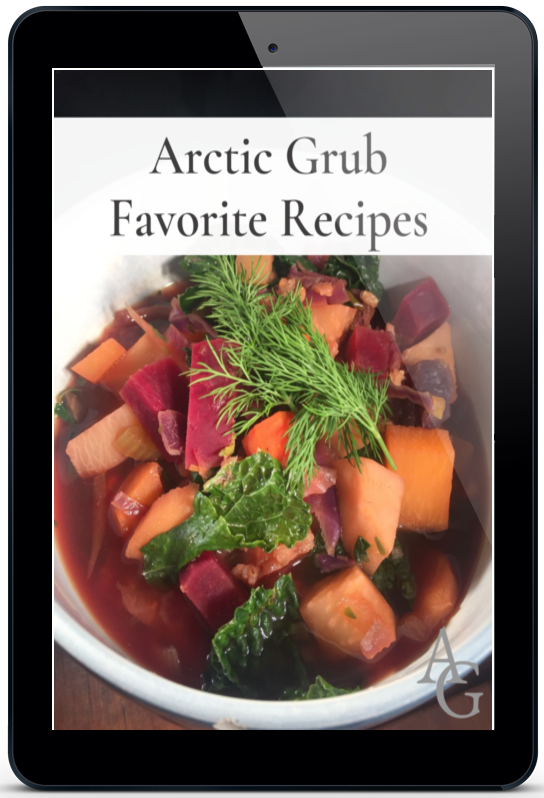
0 Comments